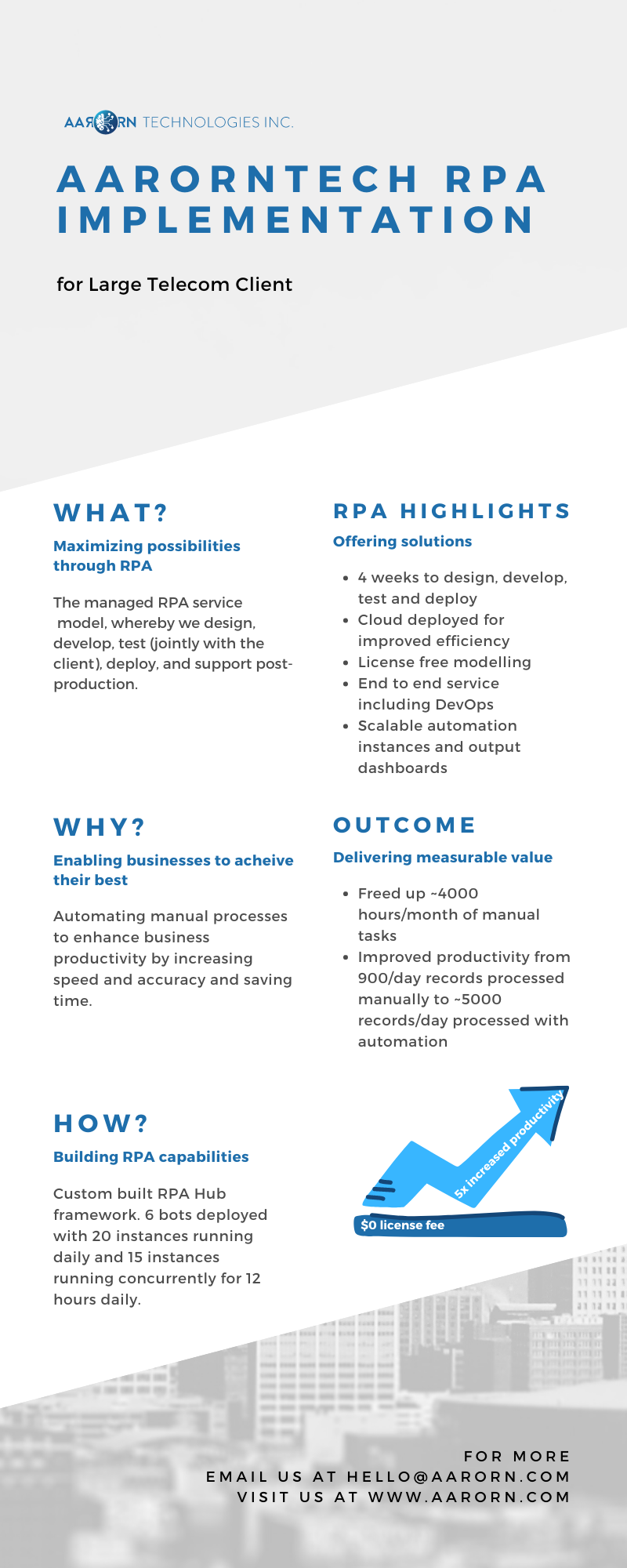Robotic process automation (RPA) enables organizations to automate routine tasks using software robots. More and more organizations are adopting RPA as a means to achieve their operational efficiencies. At AarornTech, we make the RPA journey convenient and valuable for our clients. Our team analyzes the business needs, identifies operational complexities, and helps clients overcome them using RPA, assisting organizations in managing highly repetitive, structured, and voluminous tasks such as administrative, invoicing, product tracking, accounting, etc. Here we highlight some of the crucial factors that we consider in our RPA road map.

Client infrastructure is one of the primary areas that depends upon multiple processes and procedures within various organizations. At AarornTech, we develop RPA services with varied infrastructure setups in mind as one of our development criteria. As most organizations move towards virtual machines (VMs) and the cloud, we offer RPA solutions optimized for cloud and virtual environments, require minimal computing power, and run from any computer or VM. Our solutions are OS-agnostic, including Linux and Unix, making it compatible for all our clients across industry verticals.
An essential factor in our RPA development process is scalability. We consider scalability in implementation outcomes so that the solutions today do not turn into bottlenecks tomorrow. Our automation solutions can handle the increased load when RPA bots work together to carry out various business processes. We support broadening the usage scope as businesses expand automation across multiple business units upon realizing the automation benefits. Furthermore, automated business processes often need to access and be accessed by new application and integration technologies. We ensure that this capability of expanded access is envisioned in our RPA implementation process. Our scalable architecture has provided our clients with immense automation benefits.
Our zero-licensing policy with no hidden costs allows our clients to retain perpetual rights to adopt and distribute software within their domains. Our end-to-end RPA consulting services require minimal involvement of our clients. Through our interactions, our clients offer their vision of a solution, and we illustrate the path towards achieving that vision. Our clients provide the catalog processes, tasks, and access to systems through our Process Mining software. At AarornTech, we offer a full lifecycle implementation of RPA, with the client involvement in subject matter alignment, project progress updates, and handover processes.
All our global contracts have been remote for the past decade, enabling us to carry our commitments without delays or hiccups caused due to unforeseen events. As more and more businesses employ such infrastructures during the pandemic to minimize disruptions, our business deliverables were always on schedule. Our engagements have been very lean from a team requirement perspective, yet the deliverables are comparable to larger teams. Our global teams do the fulfillment processes remotely from within or outside the country; we connect through secured mediums as required with traceable logs and activity reports for each activity, which can be submitted on a timely or as-needed basis, rendering physical engagements less crucial. We welcome kick-off and on-site meetings, with our teams coming to the forefront of implementation with physical presence; however, these do not impose hurdles on our deliveries.
Our mode of access to the clients’ systems and that of delivery are secure and convenient. RPA teams directly access client systems, and the resulting software runs on any client workstations. For regulated industries, we can access systems through existing customer consoles with standard operator rights. We ensure our engagements are compliant with regulatory processes and are secure in all aspects. We follow customers’ rule book for engagement processes and best practices, and we ensure that all regulatory requirements are met, such as PCI, DSS, CMMI, SOCSO, HIPAA, Sarbanes-Oxley Act, or any other industry-specific regulatory compliances.
With our unique approach that suits organizations of all sizes and budgets, we instill RPA to help our clients improve processes, enhance productivity, reduce operational costs, and eventually magnify their businesses’ and stakeholders’ lifetime value. Our commitment to saving the time of their valuable employees helps our clients focus on quality tasks that matter for the future of their organization.





